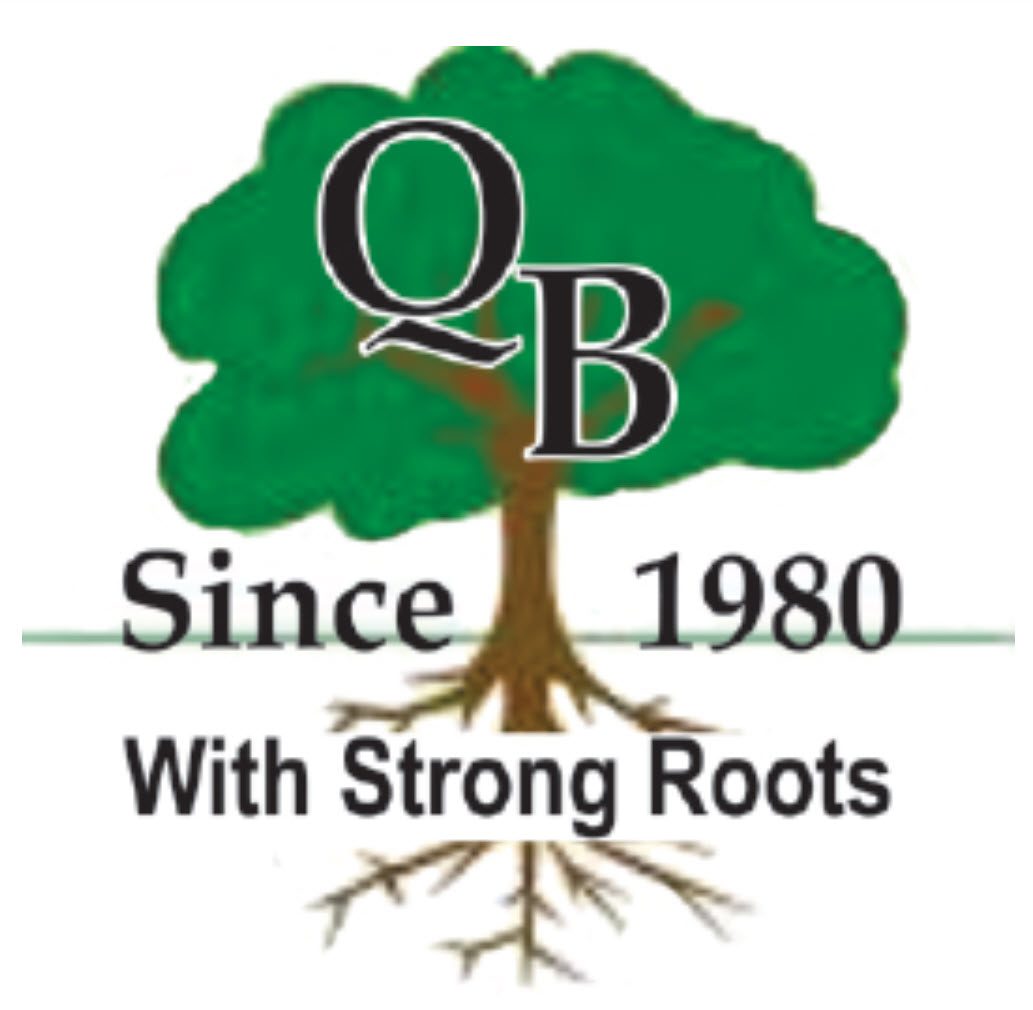- More Steenburghs Than You Might Imagine
- Bath: The Largest Local Reenactment This Year
- Genealogy Workshop: Using the Quinte Branch Library Resources
- King’s College, Ontario’s Missing Link
- Congratulations to our Ontario Volunteer Service Award Recipients
- Resources at the Campbellford-Seymour Heritage Centre
- Solving Genealogical Problems Using English Probate Records
- Getting to Know The War of 1812
- “History of Holy Name of Mary Parish” to be Republished
- Searching Effectively on Ancestry
- Eleanor Isabel Carleton Moult UE, 1929-2011
- Researching Canadian WWI Records Using Online and Traditional Resources
- “The Family in Faces” Ancestral Quilt
- Fun Times–the OGS 50th Anniversary Cruise
- Belleville Born Insulin Discovery Collaborator: James Bertram Collip
- Care of Family Papers and Photographs
- 2019 News
- 2018 News
- 2017 News
- 2016 News
- 2015 News
- 2014 News
- 2012-2013 News
- 2011-2012 News
- 2010-2011 News
- 2009-2010 News
- 2008-2009 News
- 2007-2008 News
- 2006-2007 News
- 2005-2006 News
More Steenburghs Than You Might Imagine
Presentation by Peter W. Johnson UE
If you thought STEENBURGH was a fairly rare surname, you would be thinking twice if you had attended the Reunion at Cordova Mines on July 21st. Over a hundred family members were present. The focus was on the third generation in Canada–William Henry STEENBURGH 1847-1919 and his wife Mary. He was the grandson of John and Easter STEENBURGH who settled in Murray Township in the early 1800s, and son of John Cass STEENBURGH and Phoebe Jane MAYBEE, so most of the assembled were also MAYBEE descendants.
William was one of those rare Canadians who served in the Civil War, and the Reunion included a commemorative ceremony at Rockdale Cemetery, and Civil War reenactors were present. William joined the Union Army in early 1865 and saw considerable fighting in the short time that elapsed between then and the Confederate surrender.
Thanks to Dr. Laurence BURT and Dave STEENBURGH for holding a successful and enjoyable event. Dr. BURT is also the author of a recent book on the family.
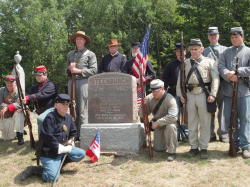
Union and Confederate reenactors gather around the Steenburgh grave marker at Rockdale Cemetery.
Photo: July 21, 2012 by Peter W. Johnson UE
Bath: The Largest Local Reenactment This Year
Article by Peter W. Johnson UE
From June 29th to July 1st, Bath and the surrounding area echoed with the sounds of musketry, and a glance towards the water could reveal tall ships about to engage in battle. It was a commemoration of the Escape of the Royal George from the pursuing American Fleet and also the American attack on Bath wherein the Two Brothers was burned and sunk.
As the biggest local reenactment this year, it drew a considerable number of reenactors including the 44th Regiment all the way from England. Of course the local group, the Canadian Fencibles were present and the Loyalist Fifes and Drums adopted the uniform of Canadian Fencibles’ drummers and participated. Not only did battles take place within Bath, but at various points as far away as Kingston. The Americans landed on Saturday and were driven out on Sunday during a street battle. Bath is located in Loyalist Township, and when the British flag was restored to its rightful place on Sunday and the audience cheered, one reenactor was heard to remark, “This really is Loyalist Township”.
The Saturday evening battle was almost like a fireworks show because as dusk approached the fire from the muskets and artillery lit up the area. At the same time, the Loyalist Fifes and Drums were honoured to participate at the evening Tattoo at Fort Henry.
Every year Bath hosts a Canada Day Parade, and for a small community, the size of the audience is quite amazing. Obviously, this year that was enhanced by the other activities taking place. Happy to report the Loyalist Fifes and Drums were named best band in the parade. Even the Snowbirds flew over Bath twice on their way to Ottawa.
Congratulations to Dave Smith and his helpers for organizing this event.
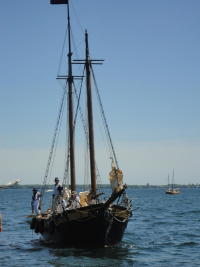
The enemy approaches Bath.
Photo: June 30, 2012 by P Johnson UE
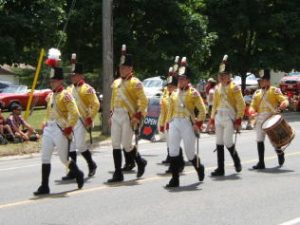
The Loyalist Fifes and Drums appearing as the Drums of the Canadian Fencibles.
Photo: July 1, 2012 by Bob Dawes
Genealogy Workshop: Using the Quinte Branch Library Resources
Presentation by Bob Dawes
Photography by Georgette Green
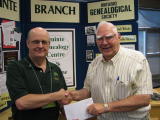
Workshop Presenter Bob Dawes is thanked by Branch Treasurer Larry McQuoid.
The meeting focused on:
- The Research Library (paper and digital files)
- The Finding Aid (in-house and online)
- CemSearch Database
- Microfilm Collection
The meeting finished with a demonstration of how to create a GEDCOM file and how to use it to experiment with your family tree in other genealogy programs without giving up your current one. There was a lively discussion about the various genealogy programs available and here again, people were anxious to try out new features by using a GEDCOM rather than committing to a change or upgrade. The consensus was that it is advantageous to use more than one program since they have different features and you can easily share your data between more than one using GEDCOM. The following free genealogy programs were demonstrated:
King’s College, Ontario’s Missing Link
Article by Bob Dawes
Photography by Georgette Green
Thirty Quinte area genealogists started their Victoria Day weekend by attending a presentation on King’s College Land Records given by Ruth Burkholder. Some new faces were apparent in the group as was OGS President Nancy Trimble who skipped cottage time to take in the meeting.
In 1797, the Upper Canada Legislative Council petitioned King George III to establish grammar schools and a college in the new province. Since there wasn’t much money to fund their establishment the King granted the exchange of Crown Land Reserves to be used and that the resultant university be called “King’s College”.
King’s College became the University of Toronto and that’s how they got into the land business. In most cases, the land was rented to farmers and the rent revenue was much-needed income for the new schools. Land Records for this land and there is a lot of it, amounting to half a million acres, over many districts, counties and townships are not held by the provincial registry offices. The King’s College records are held by the U of T Archives found at 120 St. George St., 4th Floor, Toronto, Ontario M5S 1A5. These records have never been microfilmed and cover over 100 feet of shelf space.
In addition to the transaction records associated with each parcel, there are also minute books covering both verbal and written communications with tenants and purchasers. There are also surveyor’s inventories of the properties which give a lot of details about the land and its occupiers.
If you come across an abstract that shows a King’s College transaction it will be worthwhile to check out the U of T Archives to see what additional details you can uncover about the property.
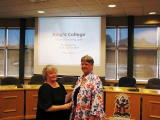
Claire Westerhauser, Quinte Branch Secretary thanks Ruth Burkholder for her presentation on King’s College Land Records.
Congratulations to our Ontario Volunteer Service Award Recipients
Article by Tina Gemmell
Photography by Rodney Green
Two volunteers from the Quinte Branch were among the recipients of the Ontario Volunteer Service Award is given by the Ontario Ministry of Citizenship and Immigration for continuous years of commitment and dedicated service to an organization. Our congratulations go to Lois Duggan of Wellington, and Georgette Green of Carrying Place, who were each presented with a stylized trillium service pin and a personalized certificate from Todd Smith, MPP of Prince Edward-Hastings at the presentation ceremony on May 2 in Belleville.
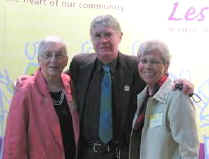
Lois Duggan (right) and Georgette Green (left) are congratulated by Branch Chair Peter Johnson UE.
Resources at the Campbellford-Seymour Heritage Centre
Article by Bob Dawes
Photography by Georgette Green
Quinte area genealogists braved a wet, spring Saturday to find out what’s new in Campbellford/Seymour. Ann Rowe, Past President of the Campbellford-Seymour Heritage Society, provided our members and guests with an overview of their activities and resources. While their charter covers more than genealogy a lot of their activities benefit those with ancestors from Campbellford/Seymour and Percy located in northeastern Northumberland County.
Ian McCullough, the current president, is transcribing the Campbellford Herald and has completed from 1870 to 1970. As information is extracted it is used to update their family tree database of area families. When completed, this will be a great resource because it covers right up to current times getting around the closure rules associated with Ontario vital registrations. Their genealogy database currently contains over 100,000 individuals and is used extensively in responding to queries from emails and visitors.
The Heritage Centre, located at 113 Front Street, Campbellford, has large collections of records in microform, print and digital media covering census records, voter lists, land records, baptisms, marriages, burials, cemeteries, court records, newspapers, local histories, maps and atlases. There are also large collections of photographs and negatives from local studios and historical artifacts. For more information see their website at www.csheritage.org.
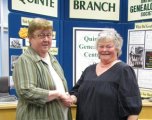
Ann Rowe, Past President of the Campbellford-Seymour Heritage Society is introduced by Claire Westerhauser, Quinte Branch Secretary.
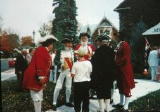
Above and below: activities and artifacts at the Campbellford-Seymour Heritage Centre.
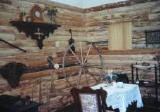
Solving Genealogical Problems Using English Probate Records
Article by Bob Dawes
Photography by Georgette Green
Over fifty people filled the Quinte West council chambers to hear Linda Reid explain how to use English probate records to solve genealogical problems.![]() She started by explaining that probate was handled by the churches until 1858 when it was taken over by the government and her presentation focused on the period since 1858 and how to use the National Probate Calendars to find death dates and wills. There are calendars covering every year since 1858 which are in book form until 1973, microfiche until 1996 and on computer after that. While these records are only available at the principal registry in London and through district offices, there are also other sources.
She started by explaining that probate was handled by the churches until 1858 when it was taken over by the government and her presentation focused on the period since 1858 and how to use the National Probate Calendars to find death dates and wills. There are calendars covering every year since 1858 which are in book form until 1973, microfiche until 1996 and on computer after that. While these records are only available at the principal registry in London and through district offices, there are also other sources.
The Latter-day Saints Family History Library in Utah has microfilm copies of the calendars from 1858 to 1957 which are also available at the Toronto Family History Centre on full-time loan. Ancestry.com has online versions for 1861 to 1941 with more being added all the time.![]() The calendar will tell you the date of death, location of death, address, executors and value of the estate. With this information you can order a copy of the will from Her Majesty’s Courts and Tribunals Service for £6.00 per copy. More information can be found at www.justice.gov.uk/courts/probate and use the link for “Copies of grants and wills” on the left side.
The calendar will tell you the date of death, location of death, address, executors and value of the estate. With this information you can order a copy of the will from Her Majesty’s Courts and Tribunals Service for £6.00 per copy. More information can be found at www.justice.gov.uk/courts/probate and use the link for “Copies of grants and wills” on the left side.![]() Since the probate calendar gives you the full death date and location, this can be used to avoid purchasing a death certificate. Obviously, if you order the will you would also get the names of family members and their relationship to the deceased. Linda stressed that you should avoid ordering a will for the first party of a marriage to die as they usually left their estate to their spouse–boring! However, when the surviving party dies they leave the estate to their children or other relatives providing a potential wealth of new family connections.
Since the probate calendar gives you the full death date and location, this can be used to avoid purchasing a death certificate. Obviously, if you order the will you would also get the names of family members and their relationship to the deceased. Linda stressed that you should avoid ordering a will for the first party of a marriage to die as they usually left their estate to their spouse–boring! However, when the surviving party dies they leave the estate to their children or other relatives providing a potential wealth of new family connections.![]() The FHL also holds copies of wills from 1858 to 1925 which can be ordered into your local FHC. To find the wills from the principal registry (London) search the library catalogue for film 1836412 and then choose the year and surname range.
The FHL also holds copies of wills from 1858 to 1925 which can be ordered into your local FHC. To find the wills from the principal registry (London) search the library catalogue for film 1836412 and then choose the year and surname range.
Overall, this presentation showed how family histories can be expanded by using readily accessible probate records.
Linda Reid is a retired librarian who lives in Toronto, Ontario. She has been researching her British roots for 25 years and is an active volunteer with the Toronto Branch of OGS and at the Toronto Family History Centre.
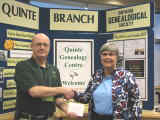
Bob Dawes, Quinte Branch Database & IT Committee Chair, introduces Linda Reid, a retired librarian and active volunteer for Toronto OGS and Toronto FHC.
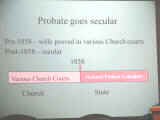
Before 1858 wills were proved in various church courts. After 1858 probate was managed by the state and recorded in the National Probate Calendars.
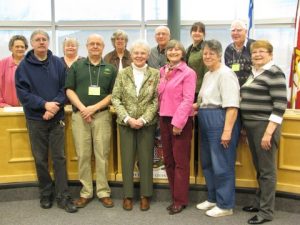
Meet the Quinte Branch Executive for 2012.
Back row, L-R: Marilyn Harry, Clare Westheuser, Lynn Heale, Rodney Green, Tracey Cuddington, Larry McQuoid; Front row, L-R: Peter Johnson, Bob Dawes, Ann Pumple, Stacy Goddard, Mary Culloden, Carole Foshay. Absent: Richard Hughes, Lewis Zandbergen, Lois Duggan, Tina Gemmell, Harriet Richards and Noreen Smith.
Getting to Know The War of 1812
Article by Stacy Goddard
Photography by Georgette Green
18th February 2012: Over thirty individuals made the trip to Council Chambers in Quinte West for the monthly meeting of the Quinte Branch of the OGS. We were missing many of our officers and staunch supporters, as the snow was falling heavily, making it impossible to make it to Trenton. However, even as we were assembling, we discovered that two of those present have antecedents from the War of 1812. We began our presentation with a discussion about how OGS members could obtain lovely certificates honouring a family member proven to have fought in the War of 1812. It was also pointed out that the OGS Conference would be held in Kingston this year and that 1812 would be ts theme. The beautiful logo for this event was designed by our own Peter Johnson and was held up for viewing. There were brochures for the Conference to be taken home and filled out. It was also mentioned that the OGS magazine Families (Nov issue) has good sources for finding ancestors of the War. Our ‘feature film’ entitled “When I meet my Doom” was then shown. It portrayed the beginning days of the war up to the Battle of Queenston Heights and the death of Sir Isaac Brock. The General’s genealogy had been printed up and there was also a brief genealogy of the Secord family and some information on the Ingersoll family, Laura Secord’s maiden name. Two computers were available for anyone to search on valuable sites for those interested in pursuing the history of the time. Two of these sites are: www.eighteentwelve.ca and www.visit1812.com. The Canadian Geographic magazine (Jan/Feb issue) was also available for its article on the Battle of Crysler’s Farm
re-enactment. Click here to read the article online.
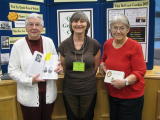 |
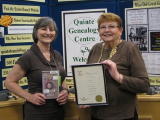 |
Stacy Goddard, Branch Librarian, and presenter of today’s programme with Lois Duggan (above) showing a picture of her ancestor Major General Francis de Rottenberg, Mable Brown (above) who has a connection with Laura Secord and Carole Foshay (above) holding a sample of the OGS “War of 1812” Heritage Certificate.
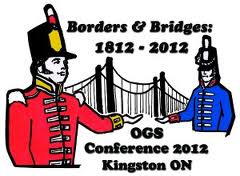
The OGS Conference logo was designed by our own Peter Johnson UE.
“History of Holy Name of Mary Parish” in Marysville, Tyendinaga Township
(to be republished)
Article by Carson Murphy
15 Feb 2012–The Roman Catholic Parish of Holy Name of Mary (or St. Mary’s) in Marysville, Tyendinaga Township, Hastings County, Ontario is celebrating its 175th Anniversary in August of 2012. The parish was founded in 1837, and was the sixth parish established in the Archdiocese of Kingston.
As part of the celebrations, the Anniversary Committee is looking to republish the “History of Holy Name of Mary Parish” book that was full of family trees connected to the parish done originally in 1987. As part of the new edition, the committee is opening the floor for new submissions to the book. This includes updates to the family trees previously included in the book (so all the marriages, births and deaths since 1987, or family members left out of the last edition). New additions to the book are also welcome – this is your chance to submit your family or branch of a family that was not included in the last edition. Photos are also welcome!!!!!
Family tree and photo submissions can be submitted electronically to [email protected].
We ask that you please label all photographs. We also ask that the family trees that are submitted are connected primarily with Marysville. There is a firm deadline of APRIL 1ST 2012, so make sure you send in your submissions beforehand to avoid disappointment!
Searching Effectively on Ancestry
Article by Stacy Goddard
Photography by Georgette Green
There was a full house of more than 80 people attending the annual Crouse-Wanamaker Lecture on January 21st in the Quinte West Council Chambers to learn about “Searching Effectively on Ancestry” from guest speaker Lesley Anderson of Ancestry.ca.
Much of what Lesley taught us about creative search strategies such as using wildcards, alternate spellings, substituting middle names and using just the surname and location applies no matter where you are searching. However, using Ancestry, there are many other options for searching that put billions of records at our disposal by using advanced search options and filters for lifespan, collections, record types and categories, as well as browsing, using the card catalog, family trees and connecting with other members. Ancestry will also suggest records based on other members’ activity and algorithms that indicate likely matches.
Lesley explained the differences between Ancestry.com for access to the United States record collection and Ancestry.ca for access to the Canadian collection. Subscriptions can be purchased for the country of choice, or the World Deluxe version which provides unlimited access to all records from the Canadian, UK, Ireland, USA and other countries’ collections. We also learned that the version of Ancestry freely available in Ontario Public Libraries lacks only the trees, newspapers and magazine collections. If you don’t want to miss out on anything, it only costs about $25 to have the worldwide subscription for a month, less for a Canadian subscription. 14 day free trials are always available and there are special discount offers on a regular basis. It appeared from a show of hands and the questions asked that many in the audience are subscribers and Lesley’s presentation has made them more knowledgeable users. They are probably more appreciative of the costs and difficulties of bringing all these databases to us after seeing the condition of some of the collections encountered, such as the parish registers for Gretna Green in Scotland.
Lesley Anderson, Partnership Development & Content Specialist for Ancestry.ca, works to develop strategic relationships with archives across Canada and acquire new Canadian historical records. passionate family history researcher for more than 35 years, she is a member of the board for the British Isles Family History Society of Greater Ottawa, both as Director of Education running educational seminars, and as Director of Programs. Lesley also volunteers at the local Family History Center, consults privately, teaches family history classes and speaks at seminars and conferences.
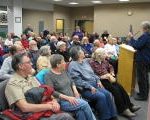
A full house attended the Crouse-Wanamaker Lecture about “Searching Effectively on Ancestry”
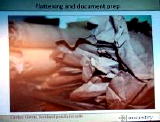
Some collections that Ancestry is digitizing and indexing include records that have not been properly stored or cared for
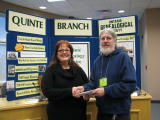
Lesley Anderson is thanked for her presentation by Peter Johnson UE
Eleanor Isabel Carleton Moult UE
Dec 22, 1929 – Dec 30, 2011
Article by Peter W. Johnson UE
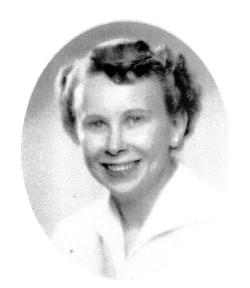
Eleanor Isabel Carleton Moult UE, (1929-2011)
The genealogical community lost a great friend and supporter with the passing of Eleanor last December. She was the daughter of the late Dr. Harry and Edith (Walker) Carleton and is survived by her three children Robert, Julie and Carol, seven grandchildren and her brother William. She was predeceased by a brother Edmund. Eleanor grew up in Norwood, and her later education was in Peterborough.
It was impossible to have been involved with genealogy in Ontario over the past several decades without meeting Eleanor. If one could claim the title of Ms. Genealogy it was Eleanor, and once you met her, you were her friend for life. She tackled with enthusiasm every query that came her way, and the answers she provided usually extended far beyond the scope of the initial query. The query need not be about one of her own family lines. She helped everyone, and they could expect a response any time of day or night!
Years back Eleanor was a dedicated member of both Toronto Branch UELAC and Toronto Branch OGS. She was heavily involved with the Loyalist Lineages book project, was co-Dominion Genealogist for a time, and more recently she was Branch Genealogist for Bay of Quinte Branch UELAC. She held that position until late 2009 when ill health prompted her to settle in a Retirement Home in Tweed. Eleanor was also a dedicated member of Quinte Branch OGS. Eleanor was an authority on the Dafoe family, and she organized a large Dafoe Reunion in Kingston in 1984. Eleanor’s claim for Loyalist ancestry was through the well documented Dafoes. In 2010 Eleanor was honoured by being inducted into Bay of Quinte Branch UELAC’s “Loyal American Hall of Honour” an award not generally bestowed upon living Loyalist descendants.
There are more good Eleanor stories than space permits, but one thing she was legendary for was the extent of her collection of genealogical books and papers. When she moved from Scarborough to Tweed in the 1990s, the superintendent of the apartment in Scarborough breathed a sigh of relief. There had the been the real concern that the weight of her collection would collapse the apartment floor! Her last residence in Belleville was actually two apartments– one for living in and one for book storage!
Eleanor passed away in Belleville on December 30th. The Service was held on January 2, 2012 at St. Paul’s Anglican Church, Roslin, Ontario. There was a full house for the Service, and at least one-third if not more of those present were there because they knew Eleanor through various genealogical societies, and she did belong to more than just the UELAC and OGS. Spring interment will be at the graveyard surrounding the Church, and it is the location where her parents are buried.
I had the pleasure of knowing Eleanor for almost forty years. UELAC member David Kanowakeron Hill Morrison UE met her more recently, and I thought his remarks via email were especially appropriate. He commented: “I credit Eleanor for introducing the UELAC to me and will always be grateful for her friendship and vast knowledge, both of which she graciously shared. She will be missed and always remembered for her wit, enthusiasm and engaging friendliness.”
It’s been said that anyone can be replaced. Actually, some people can’t be replaced, and Eleanor Carleton Moult UE was one.
Researching Canadian WWI Records Using Online and Traditional Resources
Article by Bob Dawes
Photography by Georgette Green
Quinte Branch members and guests closed the 2011 programme year with a presentation on Canadian World War I service records by Rick Roberts of Global Genealogy Supply.
Following on Remembrance Day, the previous week, the topic was timely and interesting. Rick followed one of his relatives from enlisting in 1915 to his death, in France, in 1916. In doing so, he took the audience from his Attestation Papers which were filled in upon enlistment through a variety of records which, unfortunately, ended in a cemetery. He noted that when using searchable websites that it is wise to read the search help before trying to find anything as this may help you understand how to structure your request for the best results.
The Attestation Papers gave a clue to the military unit and battalion which led to a search on the unit’s war diaries. While the war diaries don’t identify individuals unless they did something really good or bad, they do explain where the unit was and what they were doing. In this case, we were able to see a map of the battlefield and the exact location where his relative died on the front. A visit to the Commonwealth War Graves site then identified the location of his grave and a history of that particular cemetery in France.
Rick not only gave us a lot of good internet resources but also showed us how important it is to interpret the results and use them to lead onto the next search as you unravel the story of your ancestor.
The important resources that he supplied are his own at www.globalgenealogy.com/ww1 where he has consolidated a lot of the Library and Archives Canada (LAC) and Veterans Affairs (VA), as well as international sources for us and the recent book by Glen Wright, titled Canadians at War 1914-1919 which provides all the sources you need to dig up information about your WWI ancestors.
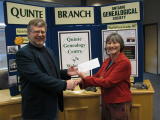
Stacy Goddard introduces Rick Roberts of Global Genealogy Online resources include Attestation at Library and Archives Canada
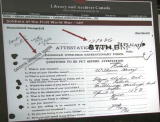
Books of Remembrance at Veteran Affairs Canada
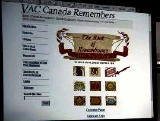 |
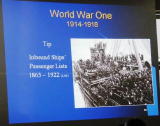 |
Inbound Ships Passenger Lists 1865-1922 at Library and Archives Canada
“The Family in Faces” Ancestral Quilt
Article by Peter Johnson UE,
Photography by Georgette Green
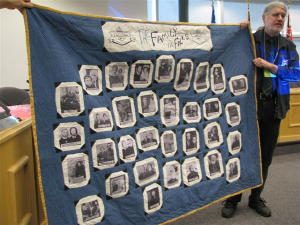
For a little “Show ‘n Tell” at the November meeting, a quilt, “The Family In Faces” was displayed. Angela Johnson had been considering such a project for several years and brought it to completion in September. The quilt features over 30 images of direct ancestors of Angela and Peter Johnson. The images were secured on cloth with the same process as is used to place images on t-shirts. Labels and dates identified each person or couple, and each image was quilted with a ‘frame’ and black cloth corners as if they were in a photo album. The shield-like motifs on either side of the title on the quilt were taken from the design of a 19th-century coffin plate. The quilt made its first appearance at a show in Frankford earlier this Fall.
Fun Times – the OGS 50th Anniversary Cruise
Article by Stacy Goddard
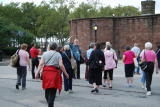 |
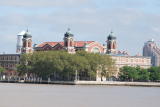 |
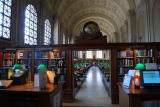 |
| Cruise group on Ellis Island | Ellis Island | Inside Boston Library |
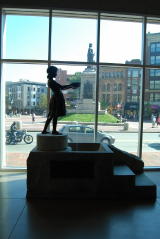 |
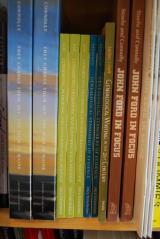 |
| Inside and outside Portland Maine Public Library | OGS publications at Longfellow House Museum store in Portland |
Libraries, archives, museums and societies where the cruisers were warmly welcomed include: Ellis Island, New York Genealogical and Biographical Society, New York Public Library, Boston Public Library, New England Historic Genealogical Society, Portland Public Library, Maine Historical Society Museum, Saint John Public Library, New Brunswick Museum, Nova Scotia Archives, and the Canadian Museum of Immigration at Pier 21.
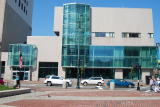 |
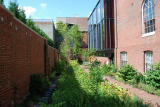 |
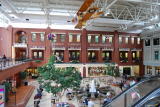 |
| Portland, Maine Public Library | Garden at Portland Historical Society | Saint John Public Library in Market Square |
The Life and Contributions of Belleville Born Insulin Discovery Collaborator: Biochemist James Bertram Collip
Article by Bob Dawes
Photography by Georgette Green
Quinte Branch members and guests gathered in the council chambers to hear Dr. George Pearce explain the contribution made by Belleville native James Bertram Collip to the discovery of insulin.
The meeting started with a presentation to Orland French, Chair of the Hastings County Historical Society, by Peter Johnson, Chair of Quinte Branch OGS, to support their archives fund. Orland gave everyone an update on the project and how it will benefit the community when it is completed.
Dr. Pearce outlined the family background of James Bertram Collip, B.A., M.A., Ph.D., M.D. (1892-1965), centered in Belleville where his father was a market gardener. He explained how his education progressed until he landed at the University of Alberta in Edmonton. The four Insulin Discovery Collaborators included Banting, Macleod, Best and Collip. While Banting and Best were credited with the discovery of insulin as a treatment for diabetes, Collip was instrumental in finding a way to perfect the extraction of insulin so it was tolerated by humans as an injection. Banting and Macleod were awarded the Nobel Prize in 1923 for the discovery of insulin. Banting shared his prize with Best, and Macleod shared his with Collip.
Dr. Pearce is presently an active volunteer with the Hastings County Historical Society.
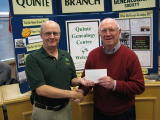
Bob Dawes introduces Dr. George Pearce
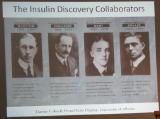
The four Insulin Discovery Collaborators, Banting, Macleod, Best and Collip
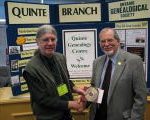
Quinte Branch Chair Peter Johnson UE donated a CD of the Mayors of Belleville Database by Dr. Donald Brearley to Orland French, Chair of the Hastings Historical Society
Care of Family Papers and Photographs
Article by Bob Dawes
Thirty-five genealogists gathered in the Quinte West Council Chambers to hear Sharon White, Archivist of the Community Archives of Belleville and Hastings County, explain what we need to do to preserve our personal archives. She explained that all things deteriorate with time and our best efforts will only slow down the process to make the article last as long as possible.
The enemies of preservation are temperature, humidity, light, pollution, dust, mould, pests, disasters, mishandling and loss. It is interesting that the last item “loss” can also apply to the digital photos stored on your computer if you don’t name and file them properly so you can retrieve them when required.
Sharon’s recommendations depended on the type of item with paper-based articles requiring storage in archival folders with sheets of acid-free paper used as separators. Keep related papers in their original groupings and remove paper clips and elastic bands. Certificates, maps and artwork should be scanned and reproduced for display with the originals stored like paper items. Never laminate anything to preserve it and if you must seal it use encapsulation where only the borders are bonded. Large items should be stored flat in boxes. Rolling is acceptable and in all cases protect the edges. If a large item won’t fit in a box, wrap it in heavy paper and tie with twill tape.
Photographs and film (negatives and slides) should be stored in paper or inert plastic (not PVC) enclosures. Also, be careful to wear hand protection when handling photographs and film to avoid fingerprints. It is no longer considered necessary to wear cotton gloves when handling old paper products but this does not apply to emulsion-based products which are susceptible to damage by body oils. Colour slides are inherently unstable due to the dyes used and need to be digitized to preserve their colours. Negatives are suitable for preservation in the appropriate containers.
Digital files are just as important to archive as old papers and photographs. These should be organized appropriately and backed-up using different media (online, external drive or DVD using the best quality media available).
Sharon closed by reminding us that the word “Archival” when used for storage products is like “Organic” for food, it is just a word and not an accepted standard. You get what you pay for!
Some resources on the web are:
Archivist’s Toolkit www.aabc.ca
CCA Publications www.cdncouncilarchives.ca (download free Redbook)
CCI resources www.cci-icc.gc.ca
AAO Preservation Resources aao-archivists.ca
Sharon White has been the Archivist of the Community Archives of Belleville and Hastings County since May 2010, when the first Archivist was hired for this archives program. These days she is busy planning the new facility that will open next year in Belleville, as well as preparing the existing collections for the move, and managing the archives started by the Hastings County Historical Society at the Heritage Centre in Cannifton.
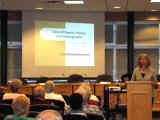 |
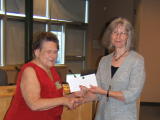 |
Branch Librarian Marilyn Harry thanks Sharon White, Archivist of the Community Archives of Belleville and Hastings County.
